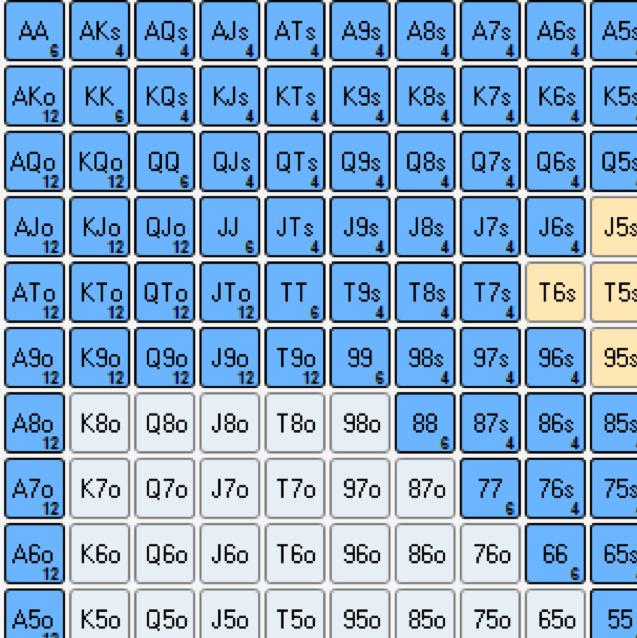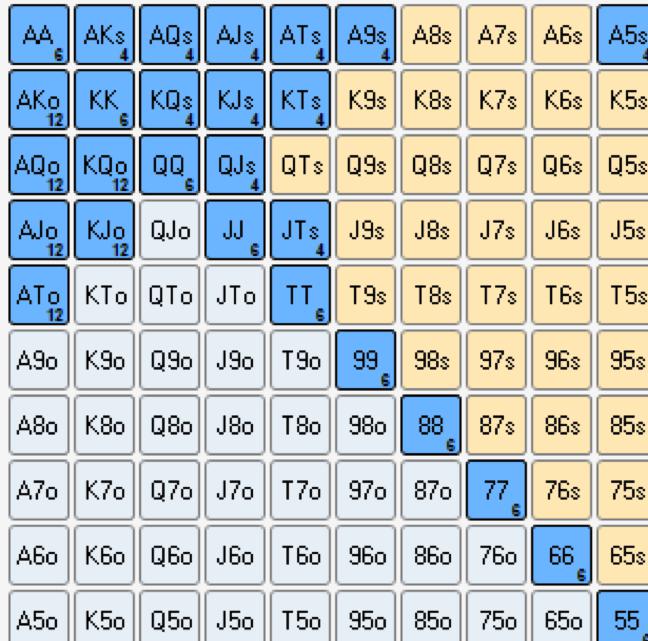Modern Blind Defense
- How poker has evolved
- How
does this affect play from the blinds?
- Why it's ok to cold-call
speculative hands
-How does board texture affect our postflop
line?
- Difference Between BB and SB
How poker has evolved
“Play tight from the blinds you are out of position!”
For many years this was one of the most common pieces of advice you'd hear about blind-defense. Is this advice really as valuable as it once used to be though?
At the time this advice was popular
there were a number of differences in the way NLHE was played. It was
common for players to open for a pot-sized raise (3.5bb) even from
the BTN. 3bets would also typically be huge by today's standards
maybe even 15bb. That's as large as some of the 4bets we are used to
seeing. In current games it's very common to see min-raises as a
standard sizing from the button. This means we get better odds to
defend from the blinds and should hence defend more frequently than
we would against a 3.5x open.
Opening ranges have also become
wider. Some very popular strategy authors even used to recommend a
30% raise-first-in range on the BTN for SH cash games. This seems
pretty absurd from a modern point of view where it's common to open
at least a 48% range on the button and then significantly
expand this depending on who is in the blinds, sometimes opening 100%
of hands.
So how do we adjust?
So given that players open significantly wider ranges with smaller sizings – it's reasonable to assume we won't be able to defend exactly the same ranges as previously. In fact, good players realise it is now correct to defend the blinds way wider than was previously considered possible.

We don't necessarily expect to make money when defending some of our weaker holdings, but this is not required! Every time we fold the BB we lose 1bb outright, and every time we fold the SB we lose 0.5bb outright. So long as we lose less than these amounts when defending we are increasing our winrate.
Let's look at at possible defending range BB vs BTN compared with how it might be defended 5 years ago.
2014 BB vs 2.5x BTN open

2009 BB vs 3.5x BTN open
Speculative hands OOP as cold-caller
“Never
cold-call suited connectors from the binds”
Here is another piece of strategy advice that probably originated
some time back in 2009. Players would routinely be folding premium
suited-connectors from the blinds vs a late position open.
The
issue is not that these hands can never be profitable defends, it's
that they can easily become non-profitable when played incorrectly.
The mistake players were making is calling solely with the intention
of trying to make hands and then giving up when they miss. The key
difference in modern blind defense strategy is that players should be
floating or check-raising the flop very aggressively when facing a
late position open. Often the raiser has a wide range and may even be
blindly continuation betting with a frequency that is way higher than
optimal. It's reasonable to assume that check-folding every time we
miss the flop is not the best strategy in this instance – we want
to attack villains wide range.

According to game-theory
calculations it's recommended to have a bluff:value ratio of 2:1 when
check-raising the flop in a single-raised-pot with 100bb stacks. This
means for every time we check-raise the flop for value we should be
check-raising the flop twice as a bluff. The average player
check-raises mainly for value and then mixes in the occasional bluff.
A lot of people know about 2:1 bluff:value ratio in this situation
but don't really believe it, and don't use it in their game.
Postflop defense as cold-caller: board texture
Firstly keep in mind that it is still ok to fold the flop after we defend preflop by cold-calling from the blinds. We will always have those hands in our range that completely miss the flop that we want to be simply check-folding.
However assuming we connect with the flop in some kind of way (look for backdoor draws, gutshots etc) we want to defend either by floating or by check-raising. Usually we base our decision on the board texture. On try board textures like the K72 rainbow we can defend by floating our entire defending range (and leading either turn or river) whereas on drawy textures such as the Jh9h5c we can defend by check-raising much more frequently.
Difference between SB and BB
One of the most common leaks regarding blind-defense is players do not understand that there should be significant differences between how the SB and the BB are defended.
When we cold-call in the BB we are closing the action and are guaranteed to see a flop. We also get a slightly better price and can defend more frequently. When we cold-call in the SB there is the threat of being squeezed by the BB. Assuming the player in the BB is very passive we can follow a similar strategy to the one we use in the BB. However if BB likes to squeeze frequently it's generally consider better to flat much tighter in the SB and use many of the hands we'd typically flat with as 3bets. Some high-stakes players never flat in the SB and 3bet their entire defending range. The 3bet poker only strategy in the SB divides opinions however, and is not universally considered to be the best strategy by all high-stakes players.


